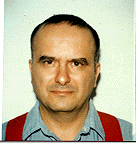
Spring/Summer 1999
Volume 6, Issue 2
Spring/Summer 1998
Volume
3, Issue 1
January 1995
Volume
2, Issue 4
October 1994
Volume
2, Issue 1
January 1994
EAC Focus
 Marc Snir
Marc Snir Researcher, IBM
Marc Snir's primary research interests are in parallel computer system architecture, system support, programming languages, libraries, tools, and algorithms. He manages the Parallel Systems Group at IBM, which focuses on the technologies needed to design and use scalable parallel computers.
"Much of what we do relates to the IBM SP product line of scalable parallel systems," says Snir. "Many of the technologies incorporated in the SP came from IBM Research. Our group developed early versions of the communication libraries, parallel file system, and parallel operating environment, and coded many of the early benchmarks and application codes." Beginning in 1992, Snir's group and the SP development team succeeded in putting the product on the market in less than 18 months. Today, nearly half of the top 500 installed supercomputers are SP systems.
Snir's group is currently developing a prototype of a scalable system where cache-coherent global memory is supported by a combination of hardware and software on top of physically distributed memory and a distributed system. Their goal is to combine the scalability of distributed systems with the convenience of shared memory. They are also working on a scalable, fault-tolerant operating system.
Snir joined IBM in 1986 as part of a theoretical group focused on the analysis of parallel computation models. He worked on everything from parallel algorithms, interconnection networks, and structure and performance analysis to the semantics of shared memory, models for memory hierarchy, and communication complexity of parallel computations. He concentrated on developing theoretical models that would be relevant to actual practice.
When the opportunity came to lead software development on the Vulcan project, at that time IBM's most ambitious parallel architecture project, Snir took on the challenge. "Moving from theoretical research to applied research entailed hard work, as well as many compromises," says Snir. "Most of these involved trading some performance or function for early presence in the marketplace. But I've found that it's much more gratifying to see our research result in a real piece of metal and silicon than in a journal paper."
Snir continues to be involved in the design of the message passing interface (MPI), a standard widely used by research and industry for parallel applications. MPI-2, which includes support for parallel I/O, dynamic scheduling, put/get-type communication, and other features, will be available later this year. "I hope MPI-2 will enjoy the same success as MPI," he says. "The CRPC has played a very important role in promoting standards for parallel software, with its contributions to High Performance Fortran, MPI, and ScaLAPACK. I expect that the CRPC will continue its institutional role as a 'keeper of standards.' "
Before joining IBM, Snir worked as a researcher at New York University (NYU) on the Ultracomputer project, one of the most influential parallel architecture research projects of the early 1980s. Snir has a B.S.C. and a Ph.D. from the Hebrew University of Jerusalem (1972 and 1979). He is an IEEE Fellow, member of the IBM Academy of Technology, and has published more than 100 journal and conference papers in various areas of parallel processing. As a member of the CRPC External Advisory Committee, Snir believes the CRPC will continue to play a leading role in making parallel systems usable by expanding its activity in parallel system software and problem solving environments. "The CRPC has been extremely successful in bringing people together from different disciplines and institutes," he says. "This, and a willingness to experiment with 'crazy' new ideas will continue to be the key to success as the center evolves and breaks the boundaries of current supercomputer technology."
Table of Contents